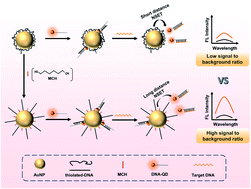Investigating the effect of 6-mercaptohexanol on the performance of a biosensor based on nanosurface energy transfer between gold nanoparticles and quantum dots†
Abstract
Nanosurface energy transfer (NSET)-based sensors have been widely developed using various pairs of nanomaterials including gold nanoparticles (AuNPs) and quantum dots (QDs). However, a low signal to background ratio is one of the most important problems that researchers are continually trying to solve. Herein, we present a 6-mercaptohexanol (MCH) modified MCH/DNA-Au-QD sensor for the detection of nucleic acids and MUC1. Interestingly, an unexpected effect of MCH was found in enhancing the fluorescence recovery ratio, therefore yielding a higher signal to background ratio. Through further investigation, we perceive the enhancement as a result of lowering of the NSET efficiency between free DNA-AuNPs and free DNA-QDs, which arises from the stretching of adsorbed DNA on the surface of AuNPs. The employment of MCH endowed the sensor with a wider linear range from 5 nM to 120 nM and a relatively lower LOD of 1.19 nM in nucleic acid detection, outperforming the original DNA-Au-QD sensor. Furthermore, the application of the sensor can be further extended to MUC1 detection. This study offers a better understanding of the NSET process between QDs and AuNPs and also initiates a new approach for the performance optimization of analogous NSET-based sensors.



 Please wait while we load your content...
Please wait while we load your content...